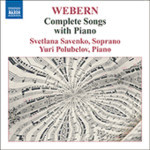
Complete Songs with Piano
 $25.00
Out of Stock
$25.00
Out of Stock6+ weeks add to cart
WEBERN
Complete Songs with Piano
Svetlana Savenko (soprano) / Yuri Polubelov (piano)
[ Naxos / CD ]
Release Date: Sunday 15 April 2007
This item is currently out of stock. It may take 6 or more weeks to obtain from when you place your order as this is a specialist product.
Through his songs, it is possible to follow Webern's development as a composer, from early traditional writing to the more experimental work of his later years, from the tonal to the atonal, and to the sparer textures for which his work became well known.
Anton Webern (1883–1945)
Complete Songs with Piano
Anton Friedrich Wilhelm von Webern was born in Vienna on 3 December 1883 in the family of a mining engineer. He received his first serious musical tuition, as a pianist and cellist, while at the Gymnasium at Klagenfurt, where he also tried to compose (his earliest pieces dating back to 1899). In 1902 Webern entered Vienna University where he studied musicology. Between 1904 and 1908 Webern studied composition with Arnold Schoenberg. Together with Alban Berg, he was among Schoenberg's first pupils, later becoming his close friend and associate. Webern's first composition to which he gave an opus number, Passacaglia for orchestra, was completed in 1908. His compositions, gradually revealing his departure from classical tonality, turned out to be more and more laconic, sometimes lasting less than one minute. Brevity and sheer concentration became hallmarks of Webern's style.
Webern left behind a large number of vocal compositions, constituting over half of his output. These compositions include choral works, pieces for voice and different ensembles of instruments and, last but not least, songs for voice and piano. Webern wrote his first songs when he was sixteen, and his last songs came out in the mid-1930s. In all probability no other genre in Webern's output outlines the composer's rapid evolution so completely and profoundly.
Webern viewed the song genre primarily as a world of melodies. The composer did not particularly subscribe to reciting poetry to musical accompaniment (Sprechstimme, speech-song) invented by Schoenberg and accepted by many of his contemporaries. Even his atonal songs are based on a drawn-out melodic line. At the same time, the composer remained sensitive to poetic words, their meaning and phonation. In Webern's later songs the interconnection of text and music becomes more mediated – musical intonation seems to symbolize the word, rather than expressing the word directly.
The first three cycles written by Webern, before his studies with Schoenberg, reveal a beginner composer at work with classical models of vocal music. The young Webern was guided by major composers of the Lied such as Schumann, Hugo Wolf, Grieg and Richard Strauss. Traditional forms such as barcarolle ('Vorfrühling'; 'Sommerabend') and chorale ('Fromm'; 'Gebet') were employed. Webern also pursued more extended forms. For example, 'Nachtgebet der Braut' is an almost operatic monologue with its sumptuous passions in the vein of Liszt and Wagner, or the ballad-like piece, 'Heimgang in der Frühe'.
New features appear in Fünf Lieder, set to verses by Richard Dehmel, which are more intricate in their musical language, sometimes akin to poems for voice and piano. Then came the period of Stefan George, whose verses Webern turned to, probably under the influence of Schoenberg. The Vier Lieder, left without an opus number, are remarkable for their predominantly murky colours, harmonic rambles and sharp emotional outbursts. These four songs remained unknown until 1965, when they were fortuitously discovered and at long last brought out in the following year. The songs in Op. 3 and Op. 4, more laconic, still reflect some elements of Webern's expressive style. Classical simplicity and clarity set the tone in Vier Lieder Op. 12, particularly with the first song, which was based on folk material ('Der Tag ist vergangen').
The last two song cycles, Op. 23 and Op. 25, belong to the later period in Webern's work, which saw the composer's experimentation with dodecaphonic technique. Their filigree musical texture corresponds to the lyrical purity of Hildegard Jone's verses, combining personal feelings with religious symbols.
Svetlana Savenko
Tracks:
3 Poems
3 Songs
3 Songs from Viae inviae, Op. 23
3 Songs, Op. 25
4 Songs
4 Songs, Op. 12
5 Songs
5 Songs from Der siebente Ring, Op. 3
5 Songs, Op. 4
8 Early Songs